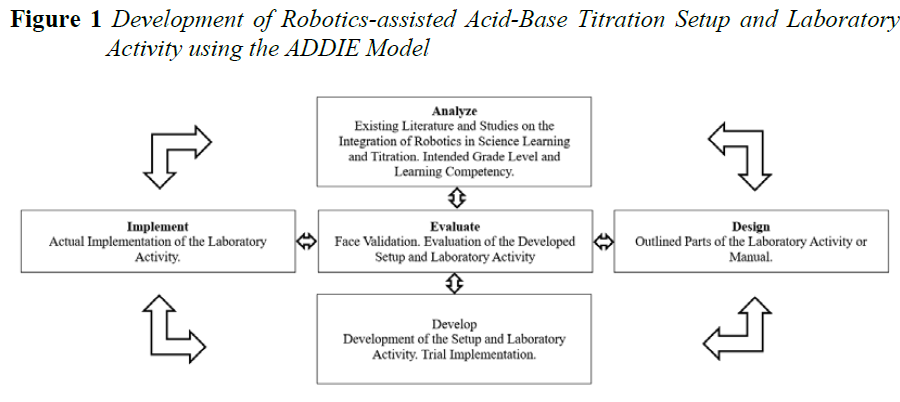Development of Robotics-Assisted Acid-Base Titration Setup and Laboratory Activity for Grade 11 Stem Students
Main Article Content
Abstract
In the 21st century, the education sector is challenged to adapt to rapid scientific and technological innovations. Educational institutions should incorporate the development of 21st-century skills including creativity, collaboration, critical thinking, and communication. One educational technology that is becoming more prevalent worldwide is robotics. However, the application of this technology to education in the Philippines is relatively new and very limited. Titration for acid-base reactions is one of the essential laboratory activities in secondary chemistry education. However, traditional or classical laboratory setups possess several potential physical barriers that can prevent effective hands-on learning and the integration of robotics can minimize these barriers. This study aimed to develop a robotics-assisted acid-base titration setup and laboratory activity for Grade 11 STEM students taking General Chemistry. Furthermore, this paper investigated the students' basic science process skills during the implementation of the developed laboratory activity and determined the students' perceptions of the activity. This quantitative study utilized a descriptive and developmental research method. The results indicated that the developed set-up was rated “excellent” on the system usability scale by teacher and student evaluation. The developed laboratory activity gained a rating of “excellent” in the teacher evaluation of format, language, and content. These results manifest that the developed setup and activity are well-designed and effectively fulfill its educational objectives. The students' basic science process skills were also “excellent” during the implementation of the activity. Furthermore, the students' perception of the activity was “very high” in interest/enjoyment, value/usefulness, and perceived choice. These results show that the activity can enhance students' scientific understanding and skills, and is also engaging, relevant, and personally meaningful. These findings further emphasize the positive impacts of robotics integration on the overall teaching-learning process.
Article Details

This work is licensed under a Creative Commons Attribution-NonCommercial-NoDerivatives 4.0 International License.
References
Adiningsih, M., Karyasa, I. & Muderawan I. (2020). Profile of students’ science process skills in acid base titration practicum at Class XI MIPA 3 SMA Negeri 1 Singaraja Bali. International Conference on Mathematics and Natural Sciences. Journal of Physics: Conference Series. Adiningsih, M. D., Karyasa, I. W., & Muderawan, I. W. (2020, July). Profile of students’ science process skills in acid base titration practicum at Class XI MIPA 3 SMA Negeri 1 Singaraja Bali. Journal of Physics: Conference Series, 1503, 012037. IOP Publishing. https://doi.org/10.1088/1742-6596/1503/1/012037.
Afnidar, A. & Hamda, S. (2015). Improving Students' Science Process Skill and Achievement Through Experiment in Laboratory: Volumetric Titration. International Conference on Technical Vocational Education and Training (ICTVET). 13-16 September 2015, Penang - Malaysia.
American Chemical Society. (2022). Importance of hands-on laboratory science. Public Policy Statement 2020-2023. Retrieved from https://www.acs.org/content/dam/acsorg/policy/publicpolicies/education/computersimulations/hands-on-science.pdf
Badeleh, A. The effects of robotics training on students’ creativity and learning in physics. Education and Information Technologies, 26, 1353–1365. https://doi.org/10.1007/s10639-019-09972-6.
Britannica, T. Editors of Encyclopedia (2022). Titration. Encyclopedia Britannica. https://www.britannica.com/science/titration
Catuday, R. (2019). Development and validation of laboratory workbook in plant biology. International Journal of Current Research, 11(03), 2194-2204. https://doi.org/10.24941/ijcr.34191.03.2019.
Cuperman, D., & Verner, I. M. (2013). Learning through creating robotic models of biological systems. International Journal of Technology and Design Education, 23, 849-866. https://doi.org/10.1007/s10798-013-9235-y.
D'Angelo, C. (2018). The impact of technology: student engagement and success. https://techandcurriculum.pressbooks.com/chapter/engagement-and-success/
Department of Education. (2016). General chemistry curriculum guide. K to 12 basic education curriculum.
Department of Education. (2020). Most essential learning competencies (MELCS). K to 12 basic education curriculum.
Department of Education. (2009). Guidelines and processes for LRMDS assessment & evaluation. Retrieved from: https://lrmds.deped.gov.ph/docs/LRMDSGuidelines.pdf
Elbir, B., Cakiroglu, B. (2018). Stem education: robotics integration in science laboratory. International Journal of Science and Research, 7(6), 904-910. https://doi.org/ 10.21275/ART20183371
Gratani, F., & Giannandrea, L. (2022, July). Towards 2030. Enhancing 21st century skills through educational robotics. Frontiers in Education, 7, 955285. https://doi.org/10.3389/feduc.2022.955285.
Hallerman, S., Lewis, C., & Dresbach, B. (2019). What is a 21st-century education? https://www.battelleforkids.org/learning-hub/learning-hub-item/what-is-a-21st-century-education/
McNulty, N. (2021). If you’re not teaching 21st Century skills using educational technology your students are in trouble. Here’s why. https://www.niallmcnulty.com/2016/07/why-teaching-21st-century-skills-using-educational-technology-is-essential/
Montemayor, T. (2018). Why include robotics in the PH school curriculum? https://www.pna.gov.ph/articles/1040784
Palisbo, V., Pusta, A., Razo, J. & Malayao, S. (2022). Dual development of board game and guided-inquiry activity in teaching electricity for Grade 5. International Journal of Science Education and Teaching, 1(3), 160-179. http://doi.org/10.14456/ijset.2022.13
Paxton, C., Jonathan, F., Hundt, A., Mutlu, B., & Hager, G. D. (2018). Evaluating methods for end-user creation of robot task plans. IEEE/RSJ International Conference on Intelligent Robots and Systems (IROS). https://doi.org/10.1109/IROS.2018.8594127.
Rani, S. A. (2017). Literature study: characteristics of hands-on physics experiment to improve science process skills. 4th ICRIEMS Proceedings. The Faculty of Mathematics and Natural Sciences. Yogyakarta State University.
Soong, R., Agmata, K., Doyle, T., Jenne, A., Adamo, A. & Simpson, A. (2019). Rethinking a timeless titration experimental setup through automation and open-source robotic technology: Making titration accessible for students of all abilities. Journal of Chemical Education, 96(7), 1497-1501. https://doi.org/10.1021/acs.jchemed.9b00025.
Verner, I. M., Revzin, L. B., & Barnea, N. (2011, April). Characteristics and educational advantages of laboratory automation in high school chemistry. In 2011 IEEE Global Engineering Education Conference (EDUCON) (pp. 8-13). IEEE. https://doi.org/10.3991/ijoe.v7iS1.1787
World Bank Group. (2021). Digital technologies in education. https://www.worldbank.org/en/topic/edutech#2
Worley, C. (2020). Automated titration vs. manual titration. Retrieved from https://www.xylem.com/siteassets/brand/si-analytics/resources/technical-brochure/automated-titration-vs-manual-titration-blog.pdf


